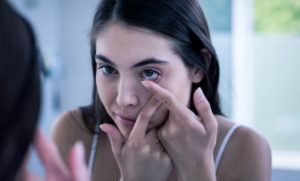May 1, 2023
By Dwight Akerman, OD, MBA, FAAO, FBCLA, FIACLE

Many therapies for myopia management have been studied and are currently used clinically, including topical atropine, bifocal, progressive and novel spectacles, overnight orthokeratology (OrthoK) and soft multifocal (MF) and dual-focus (DF) contact lenses (collectively referred to as peripheral defocus contact lenses [PDCLs]). Randomized controlled trials (RCTs) have demonstrated that both OrthoK and PDCLs effectively slow myopia progression in children.
Skidmore et al. evaluated the real-world relative efficacy of OrthoK and PDCLs in a university clinical population and compared myopia control efficacy to that previously reported in RCTs to gain insight into what utility, if any, real-world clinical data may have in understanding myopia control treatment efficacy.
Records from the University of Houston Myopia Management Service were reviewed to identify children treated with OrthoK or peripheral defocus soft contact lenses. The analyzed sample contained 273 visits from 77 patients. Annualized axial length (AL) progression rates were calculated and used as the response variable in both linear mixed-effects and nonlinear regression models. The researchers combined data for peripheral defocus contact lens brands MiSight, Biofinity, and Proclear (CooperVision), and SpecialEyes Multifocal and NaturalVue Multifocal 1 Day (Visioneering Technologies), plus the OrthoK brands Corneal Reshaping Therapy (Paragon Vision) and Vision Shaping Treatment (Euclid).
On average, children were 10.7 years of age at baseline, and 62% were female. More Asian children wore OrthoK lenses compared with peripheral defocus contacts. At baseline, children had about -3.00D of myopia and 0.75D of astigmatism in both treatment groups. Most children in the peripheral defocus contact lens group wore distance-center multifocal soft lenses (78%), as MiSight 1 Day lenses were not approved in the United States until November 2019.
Linear mixed-effects regression models using only baseline covariates showed no evidence that the annualized change in AL differed between treatments, with or without the inclusion of age, race, sex, baseline AL, or spherical equivalent refractive error.
Orthokeratology and PDCLs have been shown to provide effective axial length control in multiple randomized clinical trials. This retrospective study sought to compare the relative effectiveness of OrthoK versus PDCLs in a real-world clinic setting, including patients who are typically excluded from RCTs (e.g., higher myopes and astigmats). The researchers found no significant difference between treatments, with AL elongation rates matching those published for a range of myopia management therapies. The researchers believe this is the first study to assess the comparative effectiveness of these treatments and conclude that it is encouraging to see results from large-scale randomized clinical trials translate into real-life clinical practice.
Abstract
Retrospective Review of the Effectiveness of Orthokeratology Versus Soft Peripheral Defocus Contact Lenses for Myopia Management in an Academic Setting
Kelsea V Skidmore, Erin S Tomiyama, Martin E Rickert, Kathryn Richdale, Pete Kollbaum
Purpose: To evaluate the relative efficacy of peripheral defocus contact lenses (PDCLs) and orthokeratology (OK) in a real-world clinical population and compare these results with previous randomized controlled clinical trials.
Methods: Records from a university practice were reviewed to identify children who were treated with OK or PDCLs. The analyzed sample contained 273 visits from 77 patients. Annualized rates of axial length (AL) progression were calculated and used as the response variable in both linear mixed-effects (LME) and nonlinear regression models.
Results: On average, children were 10.7 years of age at baseline (p = 0.14 between treatments), and most patients were female. More Asian children wore OK lenses compared with PDCLs (p < 0.01). At baseline, children had ~3.00 D of myopia and 0.75 D of astigmatism in both treatment groups (p > 0.20 between treatments). LME regression models using only baseline covariates showed no evidence that the annualized change in AL differed between treatments, with or without the inclusion of age, race, sex, baseline AL or spherical equivalent refractive error. Across all possible subsets of models, age at baseline was the best predictor of annualized AL change. There was no statistical difference between parameters of an exponential decay model fitted within treatment using follow-up age as a time-varying predictor, indicating that the rate of annualized change in AL was similar for OK and PDCL.
Conclusions: Retrospective analysis of real-world clinical data found no difference in annualized AL growth between PDCL and OK. Importantly, the AL progression from this clinical setting is consistent with that reported in randomized clinical trials. Therefore, continued research of real-world performance is warranted to understand the safety and efficacy of modern myopia control treatments in the broader population
Skidmore, K. V., Tomiyama, E. S., Rickert, M. E., Richdale, K., & Kollbaum, P. (2023). Retrospective review of the effectiveness of orthokeratology versus soft peripheral defocus contact lenses for myopia management in an academic setting. Ophthalmic and Physiological Optics.
DOI: https://doi.org/10.1111/opo.13121













